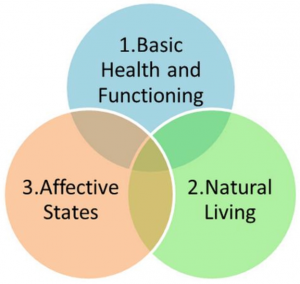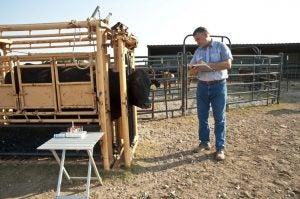Farmers and consumers alike care about the well-being of animals in food production, and it’s important that we have open conversations about this. In order to do so, however, we need a clear framework to work off of. The terms “animal welfare” and “animal rights” are sometimes confused, but they are distinct terms and frameworks that have a huge impact on animal agriculture.
Animal welfare describes an animal’s state of being, which includes health, comfort, nourishment, expression of natural behaviors, and freedom from negative states. This framework supports animal ownership and maintains that animals should be treated well. This is an ever growing scientific field, with established and developing methods to measure and describe it. This is the foundation for animal care practices safeguarded by veterinarians, farmers, ranchers, animal scientists, and other stakeholders.
Animal rights is a philosophy that views animals as deserving of rights similar to those enjoyed by humans. It is a spectrum that includes views that any animal ownership is considered exploitation, and thus any use of animals — no matter how well cared for — is considered wrong.
Animal welfare is a mix of hard and social science, with various frameworks used within the field. Since the 1960s, a concept known as the Five Freedoms has been a way to evaluate animals’ needs. The Five Freedoms are: 1. Freedom from hunger and thirst; 2. Freedom from discomfort; 3. Freedom from pain, injury, or disease; 4. Freedom to express normal behavior; and 5. Freedom from fear and distress. These have been widely used by veterinarians and other professionals when designing animal care protocols and expectations across the world.
Most animal welfare auditing systems are designed using this framework.
Another model for evaluating animal welfare is the Three Spheres, which gives a more overlapping view of areas contributing to animal welfare. The Three Spheres are: Basic Health and Functioning, which includes the health and physical fitness of the animal (like Freedoms 1, 2, and 3); Natural Living, where animals can perform natural normal behaviors in an environment that allows this (similar to Freedom 4); and Affective States, which considers the mental state of the animal to avoid negative states (i.e. pain, hunger, distress) and experience positive states (i.e. social contact, play) (related to Freedoms 1, 3, and 5).

A newer method of evaluating animal welfare, which was updated in 2020, is the Five Domains. It includes: 1. Nutrition; 2. Physical environment; 3. Health; and 4. Behavioral interactions; in the updated version it includes not just the environment, and other animals, but also interactions with humans. The first four domains influence Domain 5, Mental state, which in turn influences the welfare state of the animal.
Farmers, ranchers, veterinarians, welfare auditors, and animal scientists all evaluate animal welfare. Students can also learn and compete in Animal Welfare Assessment Contests to better prepare them for working in their future fields. It’s a multidimensional process with lots of factors and contexts to consider. Assessments need to be context specific, and consider the individual, species, environment, and management.
Animal welfare is assessed on a per animal basis. We look at environment-based measurements, such as facility design, management, space, air quality, operating procedures, handling, etc. Animal-based measurements are also used, which include evaluating lameness, body conditioning, (“fatness”), possible injuries and diseases, response to handling, growth rates (i.e. average daily gain), reproduction/fertility measurements, morbidity (disease rate), mortality (death rate), longevity, etc. Scientifically we can measure if an animal is stressed using heart rate, cortisol levels, body position, ear position, and pupil dilation, with more being developed and verified.
Animal behavior (ethology) is especially important for assessing animal welfare. We observe the animal’s movements, social interactions, cognition, learning, and any abnormal behaviors. Behaviors are connected to the biology of the animal. A better understanding of an animal’s behavior can help us improve welfare and adjust management practices to meet the needs of the animal. Understanding animal behavior also improves worker safety, reduces animal stress, increases detection of diseases and other negative states, and improves production parameters. It’s important to remember what is best for an animal is not always what us as humans perceive is best.

Animal welfare is strongly based on science and rationality with measurements and frameworks with biological context.
Animal rights, on the other hand, is a philosophy. Animal-rights activists object to the use of animals in any context. Animal-rights activists often work toward legislation and social changes to improve the humane care of animals until all animals are no longer owned or used by humans. They often employ anthropomorphism, which is when human characteristics are given to an animal, to create an emotional response and work toward giving animals legal “personhood.” Unfortunately anthropomorphism can cause animal welfare problems when people expect animals to behave and have the same needs as humans.
Extreme animal-rights activists often employ illegal and dangerous tactics that put the welfare of humans and animals at risk, such as trespassing and stealing animals from farms. Some of these organizations are classified as domestic terrorists by the U.S. government. Other animal rights organizations employ more subtle tactics such as protests, misinformation campaigns (including anti-ag “documentaries”), lobbying, campaigns targeting children, pressuring investors and food companies, pushing alt/plant-based proteins, lying to people to get them to donate while misappropriating funds, and more.

Organizations such as HumaneWatch, Animal Ag Alliance, and Protect the Harvest monitor and share information regarding these organizations and their tactics.
So why does this matter? We can all agree that animals are a vital part of our world and should have a good life. Animal welfare is an interesting science with a strong back and forth between different stakeholders, including experts such as animal scientists, farmers, ranchers, and veterinarians, and the public. It’s important that those of us in agriculture communicate about hot topics like animal welfare. It’s difficult to address animal welfare without dealing with misconceptions spread by animal-rights activists. Animal welfare and animal rights are distinct concepts that both influence how people view animals and agriculture. Confusion between them presents a challenge for agricultural communicators.
Ultimately we must work to bridge the gap between experts in agriculture and the public using shared beliefs, active listening, and increased transparency of practices and the practicalities behind them. Animal welfare is a pillar of animal agriculture. High quality animal welfare matters because it is the right thing to do ethically and ensures sustainability and profitability. If we don’t step up to communicate, we know who will.
Michelle Miller, the “Farm Babe,” is an internationally recognized keynote speaker, writer, and social media influencer and travels full time to advocate for agriculture. She comes from an Iowa-based row crop and livestock farming background and now resides on a timber farm in North Central Florida.



